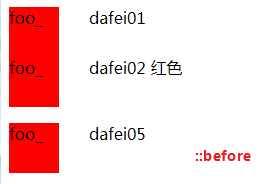选择器 -css
选择器 -css
项目和实际中使用频率高的后代选择器 和 子代选择器 和 伪元素
- (01)id 选择器(#myid)
- (02)类选择器(.myclassname)
- (03)标签选择器(div,h1,p)
- (04)后代选择器(h1 p)
- (05)相邻后代选择器(子)选择器(ul>li)
- (06)兄弟选择器(li~a)
- (07)相邻兄弟选择器(li+a)
- (08)属性选择器(a[rel=”external”])
- (09)伪类选择器(a:hover,li:nth-child)
- (10)伪元素选择器(::before、::after)
- (11)通配符选择器(*)
后代选择器
1
2
3
4
5
6
7
8
9
10
11
12
13
14
15
16
17
18
19
20
21
22
23
24
|
<style>
div p span{
color: #ff0000;
}
</style>
<span>dafei01</span>
<div>
<span>dafei02</span>
</div>
<div>
<p>
<span>dafei03 红色 </span>
<strong>
<span>dafei04 红色</span>
</strong>
</p>
</div>
<p>
<span>dafei05</span>
</p>
|
子代选择器
1
2
3
4
5
6
7
8
9
10
11
12
13
14
15
16
17
18
19
20
21
22
23
24
25
26
|
<style>
div > p > span {
color: #ff0000;
}
</style>
<span>dafei01</span>
<div>
<span>dafei02</span>
</div>
<div>
<p>
<span>dafei03 红色 </span>
<strong>
<span>dafei04</span>
</strong>
<span>dafei06 红色 </span>
</p>
</div>
<p>
<span>dafei05</span>
</p>
|
伪元素 ::before 和 ::after
1
2
3
4
5
6
7
8
9
10
11
12
13
14
15
16
17
18
19
20
21
22
23
24
25
26
27
28
29
30
31
32
33
34
35
36
37
38
39
40
41
42
43
44
45
46
47
48
49
50
51
52
53
54
55
56
57
58
59
60
61
62
| 其他不常用的伪元素
::first-letter 选择指定元素的第一个单词
::first-line 选择指定元素的第一行
::selection 选择指定元素中被用户选中的内容
01) --------------------------------------------------------------------------
<style>
/*
所有的span标签前面添加foo_
也可以是图片 content: url('./img.png')
*/
/*这2种等效,习惯选择第一种,使用2个冒号,
其实就是为了 把伪元素和伪类区分开*/
/*
这里的content 属性不能省略
*/
span::before {
content: 'foo_';
}
</style>
<span>dafei01</span>
<div>
<span>dafei02 红色</span>
</div>
<div>
<p>
<span>dafei03</span>
<strong>
<span>dafei04</span>
</strong>
<span>dafei06</span>
</p>
</div>
<p>
<span>dafei05</span>
</p>
02) ----------------------------------------------------------------------------
<style>
span::before {
content: 'foo_';
background-color: #ff0000;
display: inline-block;
width: 50px;
height: 50px;
margin-right: 30px;
}
</style>
<span>dafei01</span>
<div>
<span>dafei02 红色</span>
</div>
<p>
<span>dafei05</span>
</p>
|

相邻兄弟选择器
1
2
3
4
5
6
7
8
9
10
11
12
13
14
15
16
17
18
19
20
21
22
23
24
25
26
27
28
|
<style>
div + p +span{
color: #ff0000;
}
</style>
<span>dafei01</span>
<div>
<span>dafei02</span>
</div>
<div>
<p>
<span>dafei03 </span>
<strong>
<span>dafei04</span>
</strong>
<span>dafei06 </span>
</p>
</div>
<p>
<span>dafei05</span>
</p>
<span>dafei07 红色</span>
<span>dafei08</span>
|
属性选择器
1
2
3
4
5
6
7
8
9
10
11
12
13
14
| <style>
.box {
width: 200px;
height: 200px;
background-color: #c0c0c0;
}
.box[style] {
background-color: #ff6b81;
}
</style>
<div class="box"></div>
<div class="box" style="font-size: 20px"></div>
|
并集选择器
1
2
3
4
5
6
7
8
9
10
11
12
13
14
15
16
17
18
19
20
21
22
23
24
25
|
<style>
div, p, span {
color: #ff0000;
}
</style>
<span>dafei01 红色</span>
<div>
<span>dafei02 红色</span>
</div>
<div>
<p>
<span>dafei03 红色</span>
<strong>
<span>dafei04 红色</span>
</strong>
<span>dafei06 红色</span>
</p>
</div>
<p>
<span>dafei05 红色</span>
</p>
<h5>dafei07</h5>
|
交集选择器
1
2
3
4
5
6
7
8
9
10
11
12
13
14
15
16
17
18
19
20
21
22
23
24
25
|
<style>
div.class_foo {
color: #ff0000;
}
</style>
<span class="class_foo">dafei01</span>
<div class="class_foo">
<span>dafei02 红色</span>
</div>
<div>
<p class="class_foo">
<span class="class_foo">dafei03</span>
<strong>
<span class="class_foo">dafei04</span>
</strong>
<span>dafei06</span>
</p>
</div>
<p class="class_foo">
<span>dafei05</span>
</p>
|
伪类选择器 nth-child
1
2
3
4
5
6
7
8
9
10
11
12
13
14
15
16
17
18
19
| ul>li:nth-child(2) {
background-color: yellowgreen;
}
ul>li:nth-child(even) {
background-color: yellowgreen;
}
ul>li:nth-child(odd) {
background-color: yellowgreen;
}
ul>li:nth-child(2n+1) {
background-color: yellowgreen;
}
<ul>
<li>1</li>
<li>2</li>
<li>3</li>
<li>4</li>
</ul>
|
伪类选择器 :not
1
2
3
4
5
6
7
| h2:not([data-fei]){
color: yellowgreen;
}
<h2 data-fei="da">1111111</h2>
<h2>2222222222</h2>
<h2>333333333333</h2>
|
通配符选择器
1
2
3
4
5
| [attribute^=value] a[src^="https"] 选择每一个src属性的值以"https"开头的元素
[attribute$=value] a[src$=".pdf"] 选择每一个src属性的值以".pdf"结尾的元素
[attribute*=value] a[src*="fei"] 选择每一个src属性的值包含子字符串"fei"的元素
[attribute*=value] a[id*="fei"] 选择每一个id属性的值包含子字符串"fei"的元素
|
其他
伪类与伪元素的区别
css 引入伪类和伪元素概念是为了格式化文档树以外的信息。也就是说,伪类和伪元素是用来修饰不在文档树中的部分,比如,一句话中的第一个字母,或者是列表中的第一个元素。
伪类用于当已有的元素处于某个状态时,为其添加对应的样式,这个状态是根据用户行为而动态变化的。比如说,当用户悬停在指定的元素时,我们可以通过:hover 来描述这个元素的状态。
伪元素用于创建一些不在文档树中的元素,并为其添加样式。它们允许我们为元素的某些部分设置样式。比如说,我们可以通过::before 来在一个元素前增加一些文本,并为这些文本添加样式。虽然用户可以看到这些文本,但是这些文本实际上不在文档树中。
